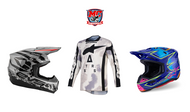How to Prepare Your Helmet for Dusty, Muddy, and Rocky Trails
Posted by undefined
Motorcycle Riding Gear is often assumed to be universal. Boots are boots, helmets are helmets, jackets are jackets, right? Just lace up the boots, put on the armor, and get the bike roaring.
Alas, it isn't that simple. Environmental conditions make a huge difference. Cruisers are great for highways, but you wouldn't take them off-roading, at least not without any prep. Today, we're going to talk about your motorcycle helmet, the most important piece of safety equipment you own, and how you can ensure it is ready to take on clouds of dust, sheets of mud, and sudden debris; the great off-road.
Vision Protection: Defending Your Window to the Trail
We can all universally agree that the worst sense to lose whilst riding a motorcycle is our sight. Visibility wins, and it's not even a competition. Naturally, this means that visibility is non-negotiable, and this is even more true when you're riding around unpredictable and unfamiliar rocky trails.
Seal the Eye Port Against Fine Dust
If you're using a full-face helmet with an integrated visor, those fine particles will find every tiny crack if the visor seal isn't proper. You can apply a small bead of silicone grease (sparingly, and only to the rubber seal itself) in order to create a more airtight barrier. However, most serious off-road riding gear usually encourages you to use goggles, as they are far superior in terms of dust sealing and offer a better field of view.
Goggles are your best friend as long as you've got the right fit, and thankfully, there are plenty of durable riding goggles for off-road adventures out there. Ensure they fit snugly within the helmet's eye port and against your face. You must have noticed rally riders tearing off their visor lenses; we recommend opting for those or roll-off systems if you intend to go into extremely muddy or dusty conditions.
Tear-offs are thin, clear sheets applied to the goggle lens. When your vision is obscured by a splash of mud, you simply tear off the top layer for instant clarity. A roll-off system uses a film that rolls across the lens, giving you a fresh, clean view with a simple pull. This small investment makes a world of difference in safety and enjoyment.
Interior Integrity: Keeping the Comfort in the Chaos
You see, as the battle against Gaia rages on outside, the interiors aren't free from chaos either. Your helmet's interior is battling sweat, heat, and the dust that does manage to get inside. Let's explore ways to manage it and make the interiors as comfortable as possible.
The Balaclava Barrier
The simplest and most effective piece of interior off-road riding gear is a washable helmet liner, skull cap, or balaclava. This thin piece of fabric acts as a sacrificial layer that absorbs sweat and oil from your head, preventing them from soaking into the helmet's expensive, non-removable EPS liner.
It also prevents the buildup of dust-infused sweat, drastically cutting down on the frequency of deep interior cleaning and protecting the delicate anti-bacterial fabrics of the cheek pads. Just wash the balaclava after every ride, and your helmet stays fresh.
Pre-Emptive Vent Management
Without proper airflow, the inside of your helmet is going to feel quite suffocating. To make sure that issue doesn't arise when you're up and about on some rocky trail, off-road helmets tend to have larger, more prominent vents.
Now, whilst that is a good thing, every story has two sides. These bigger vents act like dust magnets and get the inside of your helmet dirty. You cannot fully block them either because, well, you need airflow, but you can ensure all vent mechanisms are fully operational and free of prior dirt. Before a dusty ride, a quick blast of compressed air can clear the tiny channels. For extremely heavy dust, some riders use thin, breathable mesh or foam over intake vents (not exhaust) to filter the worst of the particles, but only if they are willing to accept a slight trade-off in airflow.

Shell and Hardware: Fortifying the Exterior
The shell is the very first line of defense, and it needs to be tough enough to handle all that comes its way. Motorcycle helmet manufacturers, obviously, know this and design the main shell to be able to withstand quite the abuse. However, there are some helmet maintenance tips you should still follow:
A Protective Coat for the Outer Shell
You can apply a coat of quality wax or a dedicated helmet protectant polish to a glossy finish to make cleaning a muddy shell significantly easier later. The slick surface resists dirt adhesion and helps mud simply slide off. For matte finishes, stick to specific matte cleaners, as traditional waxes can create unwanted shiny spots.
Lubricate the Moving Parts
This is pretty general advice, and so it applies to motorcycle riding gear as well. Any piece of equipment you may have, helmet included, that has moving parts, like the visor pivot points or the strap buckle (in case of the helmet), it is best to thoroughly clean these components and apply the appropriate lubricant. This way, you ensure they work smoothly and prevent any grinding. Not lubricating their equipment is one of those common mistakes every motorcycle rider should avoid.
Post-Ride Priority: The Immediate Cleanup
We know, post-ride, you just want to relax, hit the bed, and do absolutely nothing for the next two days. Yet, you must stay strong for a couple more hours, as letting mud or dust bake into your helmet overnight is an absolute disaster.
So, when you get home, hose down the helmet. For dry dust, a soft, damp microfiber cloth works well. Avoid rubbing dry dirt, as it acts like sandpaper and ruins your helmet's finish. Patience is key here: place a warm, wet towel over any stubborn spots for ten minutes to soften the grime before gently wiping.
Conclusion: Ride Ready, Head Protected
Preparing your motorcycle helmet for the rigors of off-road conditions is more than just a chore; it's an essential part of your safety ritual. By focusing on maintaining clear vision with quality goggles and tear-offs, protecting the interior with a balaclava, and keeping the shell and hardware slick and secure, you ensure your most vital piece of motorcycle riding gear performs flawlessly when you need it most. Get your gear prepped, maintain that focus, and go enjoy the wild ride with a crystal-clear view ahead.
Frequently Asked Questions
Q: Can I put my helmet's removable interior pads in a washing machine?
A: Most manufacturers recommend hand washing the cheek pads and liner in a basin with mild, non-toxic detergent (like baby shampoo or wool wash) and then allowing them to air dry completely. Machine washing can cause the material and foam to break down prematurely.
Q: How can I clean fine dust out of the tiny crevices and vents?
A: The most effective method is using a soft-bristled toothbrush to gently agitate the dirt, followed by a blast of compressed air (from a can or a low-pressure compressor nozzle) to completely clear the channels.
Q: What should I use to safely clean my goggles lens without scratching it?
A: Only use a dedicated goggle cleaning solution or warm, clean water with a soft, clean microfiber cloth. Never use paper towels, cleaning sprays with ammonia, or your glove, as these will scratch the anti-fog or mirrored coatings.

